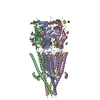[English] 日本語
 Yorodumi
Yorodumi- PDB-8fsb: Full-length mouse 5-HT3A receptor in complex with serotonin, open-like -
+ Open data
Open data
- Basic information
Basic information
| Entry | Database: PDB / ID: 8fsb | |||||||||
|---|---|---|---|---|---|---|---|---|---|---|
| Title | Full-length mouse 5-HT3A receptor in complex with serotonin, open-like | |||||||||
 Components Components | 5-hydroxytryptamine receptor 3A | |||||||||
 Keywords Keywords | TRANSPORT PROTEIN / agonist / cys-loop / pLGIC / ion channel | |||||||||
| Function / homology |  Function and homology information Function and homology informationNeurotransmitter receptors and postsynaptic signal transmission / serotonin-gated cation-selective signaling pathway / serotonin-activated cation-selective channel complex / serotonin-gated monoatomic cation channel activity / serotonin receptor signaling pathway / serotonin binding / : / cleavage furrow / ligand-gated monoatomic ion channel activity involved in regulation of presynaptic membrane potential / postsynaptic membrane / identical protein binding Similarity search - Function | |||||||||
| Biological species |  | |||||||||
| Method | ELECTRON MICROSCOPY / single particle reconstruction / cryo EM / Resolution: 2.75 Å | |||||||||
 Authors Authors | Felt, K.C. / Chakrapani, S. | |||||||||
| Funding support |  United States, 2items United States, 2items
| |||||||||
 Citation Citation |  Journal: Nat Struct Mol Biol / Year: 2024 Journal: Nat Struct Mol Biol / Year: 2024Title: Structural basis for partial agonism in 5-HT receptors. Authors: Kevin Felt / Madeleine Stauffer / Leslie Salas-Estrada / Peter R Guzzo / Dejian Xie / Jinkun Huang / Marta Filizola / Sudha Chakrapani /   Abstract: Hyperactivity of serotonin 3 receptors (5-HTR) underlies pathologies associated with irritable bowel syndrome and chemotherapy-induced nausea and vomiting. Setrons, a class of high-affinity ...Hyperactivity of serotonin 3 receptors (5-HTR) underlies pathologies associated with irritable bowel syndrome and chemotherapy-induced nausea and vomiting. Setrons, a class of high-affinity competitive antagonists, are used in the treatment of these conditions. Although generally effective for chemotherapy-induced nausea and vomiting, the use of setrons for treating irritable bowel syndrome has been impaired by adverse side effects. Partial agonists are now being considered as an alternative strategy, with potentially less severe side effects than full antagonists. However, a structural understanding of how these ligands work is lacking. Here, we present high-resolution cryogenic electron microscopy structures of the mouse 5-HTR in complex with partial agonists (SMP-100 and ALB-148471) captured in pre-activated and open-like conformational states. Molecular dynamics simulations were used to assess the stability of drug-binding poses and interactions with the receptor over time. Together, these studies reveal mechanisms for the functional differences between orthosteric partial agonists, full agonists and antagonists of the 5-HTR. | |||||||||
| History |
|
- Structure visualization
Structure visualization
| Structure viewer | Molecule:  Molmil Molmil Jmol/JSmol Jmol/JSmol |
|---|
- Downloads & links
Downloads & links
- Download
Download
| PDBx/mmCIF format |  8fsb.cif.gz 8fsb.cif.gz | 374.7 KB | Display |  PDBx/mmCIF format PDBx/mmCIF format |
|---|---|---|---|---|
| PDB format |  pdb8fsb.ent.gz pdb8fsb.ent.gz | 304.2 KB | Display |  PDB format PDB format |
| PDBx/mmJSON format |  8fsb.json.gz 8fsb.json.gz | Tree view |  PDBx/mmJSON format PDBx/mmJSON format | |
| Others |  Other downloads Other downloads |
-Validation report
| Summary document |  8fsb_validation.pdf.gz 8fsb_validation.pdf.gz | 1.3 MB | Display |  wwPDB validaton report wwPDB validaton report |
|---|---|---|---|---|
| Full document |  8fsb_full_validation.pdf.gz 8fsb_full_validation.pdf.gz | 1.3 MB | Display | |
| Data in XML |  8fsb_validation.xml.gz 8fsb_validation.xml.gz | 66.1 KB | Display | |
| Data in CIF |  8fsb_validation.cif.gz 8fsb_validation.cif.gz | 95.9 KB | Display | |
| Arichive directory |  https://data.pdbj.org/pub/pdb/validation_reports/fs/8fsb https://data.pdbj.org/pub/pdb/validation_reports/fs/8fsb ftp://data.pdbj.org/pub/pdb/validation_reports/fs/8fsb ftp://data.pdbj.org/pub/pdb/validation_reports/fs/8fsb | HTTPS FTP |
-Related structure data
| Related structure data |  29418MC  8frwC  8frxC  8frzC  8fspC  8fszC M: map data used to model this data C: citing same article ( |
|---|---|
| Similar structure data | Similarity search - Function & homology  F&H Search F&H Search |
- Links
Links
- Assembly
Assembly
| Deposited unit | 
|
|---|---|
| 1 |
|
- Components
Components
| #1: Protein | Mass: 62349.812 Da / Num. of mol.: 5 Source method: isolated from a genetically manipulated source Source: (gene. exp.)   #2: Sugar | ChemComp-NAG / #3: Chemical | ChemComp-SRO / Has ligand of interest | Y | Has protein modification | Y | |
|---|
-Experimental details
-Experiment
| Experiment | Method: ELECTRON MICROSCOPY |
|---|---|
| EM experiment | Aggregation state: PARTICLE / 3D reconstruction method: single particle reconstruction |
- Sample preparation
Sample preparation
| Component | Name: 5-HT3A pentamer in complex with orthosteric ligand serotonin Type: COMPLEX / Entity ID: #1 / Source: RECOMBINANT |
|---|---|
| Molecular weight | Value: 0.331 MDa / Experimental value: NO |
| Source (natural) | Organism:  |
| Source (recombinant) | Organism:  |
| Buffer solution | pH: 8 |
| Specimen | Conc.: 2.6 mg/ml / Embedding applied: NO / Shadowing applied: NO / Staining applied: NO / Vitrification applied: YES |
| Specimen support | Grid material: COPPER / Grid type: Quantifoil R1.2/1.3 |
| Vitrification | Instrument: FEI VITROBOT MARK I / Cryogen name: ETHANE / Humidity: 100 % / Chamber temperature: 277 K |
- Electron microscopy imaging
Electron microscopy imaging
| Experimental equipment |  Model: Titan Krios / Image courtesy: FEI Company |
|---|---|
| Microscopy | Model: FEI TITAN KRIOS |
| Electron gun | Electron source:  FIELD EMISSION GUN / Accelerating voltage: 300 kV / Illumination mode: FLOOD BEAM FIELD EMISSION GUN / Accelerating voltage: 300 kV / Illumination mode: FLOOD BEAM |
| Electron lens | Mode: BRIGHT FIELD / Nominal magnification: 81000 X / Nominal defocus max: 1800 nm / Nominal defocus min: 800 nm / Cs: 2.7 mm / C2 aperture diameter: 100 µm |
| Specimen holder | Cryogen: NITROGEN / Specimen holder model: FEI TITAN KRIOS AUTOGRID HOLDER |
| Image recording | Electron dose: 60 e/Å2 / Film or detector model: GATAN K3 (6k x 4k) |
| EM imaging optics | Energyfilter slit width: 20 eV |
- Processing
Processing
| EM software |
| ||||||||||||||||||||||||||||||||||||
|---|---|---|---|---|---|---|---|---|---|---|---|---|---|---|---|---|---|---|---|---|---|---|---|---|---|---|---|---|---|---|---|---|---|---|---|---|---|
| CTF correction | Type: PHASE FLIPPING AND AMPLITUDE CORRECTION | ||||||||||||||||||||||||||||||||||||
| Symmetry | Point symmetry: C5 (5 fold cyclic) | ||||||||||||||||||||||||||||||||||||
| 3D reconstruction | Resolution: 2.75 Å / Resolution method: FSC 0.143 CUT-OFF / Num. of particles: 49658 / Symmetry type: POINT | ||||||||||||||||||||||||||||||||||||
| Atomic model building | Space: REAL | ||||||||||||||||||||||||||||||||||||
| Refine LS restraints |
|
 Movie
Movie Controller
Controller







 PDBj
PDBj





